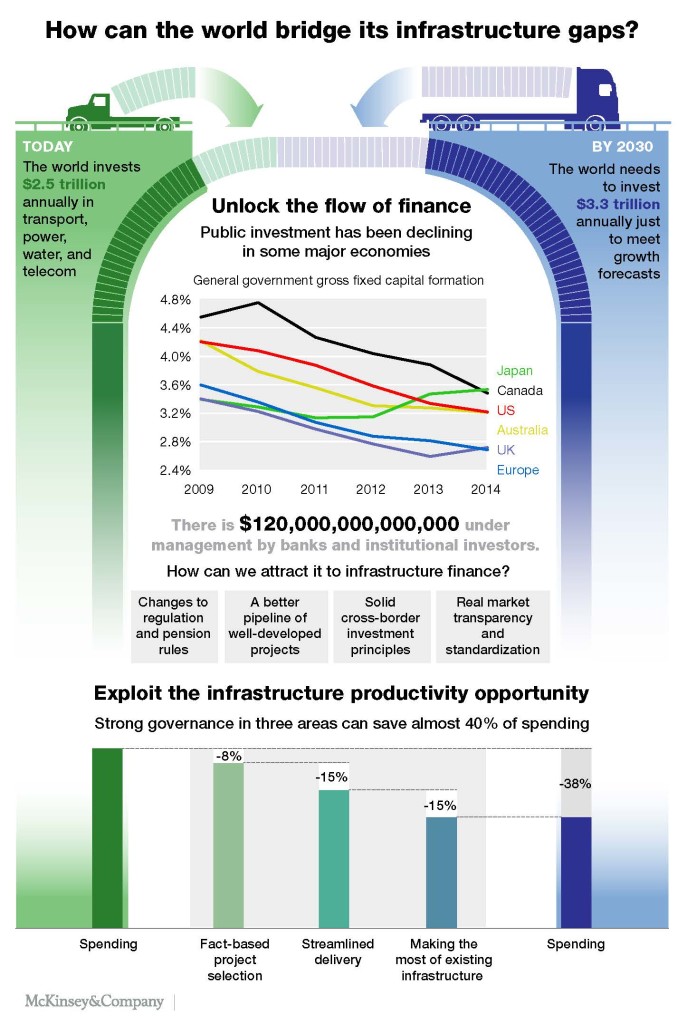Bridging Infrastructure Gaps
Today the world invests some $2.5 trillion a year in the transportation, power, water, and telecom systems on which businesses and populations depend. Yet this amount continues to fall short of the world’s ever-expanding needs, which results in lower economic growth and deprives citizens of essential services. Building on MGI’s 2013 report Infrastructure productivity: How to save $1 trillion a year, this research updates our estimates of the world’s infrastructure needs and projected investment shortfalls. It also offers refined recommendations for bridging those gaps. Among our findings:
- From 2016 through 2030, the world needs to invest about 3.8 percent of GDP, or an average of $3.3 trillion a year, in economic infrastructure just to support expected rates of growth. Emerging economies account for some 60 percent of that need. But if the current trajectory of underinvestment continues, the world will fall short by roughly 11 percent, or $350 billion a year. The size of the gap triples if we consider the additional investment required to meet the new UN Sustainable Development Goals.
- Infrastructure investment has actually declined as a share of GDP in 11 of the G20 economies since the global financial crisis, despite glaring gaps and years of debate about the importance of shoring up foundational systems. Cutbacks have occurred in the European Union, the United States, Russia, and Mexico. By contrast, Canada, Turkey, and South Africa increased investment.
- There is substantial scope to increase public infrastructure investment. Governments can increase funding streams by raising user charges, capturing property value, or selling existing assets and recycling the proceeds for new infrastructure. In addition, public accounting standards could be brought in line with corporate accounting so infrastructure assets are depreciated over their life cycle rather than adding to deficits during construction. This change could reduce pro-cyclical public investment behavior.
- Corporate finance makes up about three-quarters of private finance. Unleashing investment in privatized sectors requires regulatory certainty and the ability to charge prices that produce an acceptable risk-adjusted return as well as enablers such as spectrum or land access, permits, and approvals.
- Public-private partnerships have assumed a greater role in infrastructure, although there is continued controversy about whether they deliver higher efficiency and lower costs. Either way, they will continue to be an important source of financing in the future. But since they account for only about 5 to 10 percent of total investment, they are unlikely to provide the silver bullet that will solve the funding gap. Public and corporate investment remain much larger issues.
- Institutional investors and banks have $120 trillion in assets that could partially support infrastructure projects. Some 87 percent of these funds originate from advanced economies, while the largest needs are in middle-income economies. Matching these investors with projects requires solid cross-border investment principles. Impediments that restrict the flow of financing, from regulatory rulings on investment in infrastructure assets to the absence of an efficient market, have to be addressed. The most important step, however, is improving the pipeline of bankable projects.

Beyond ramping up finance, there is even bigger potential in making infrastructure spending more effective. Accelerating productivity growth in the construction industry, which has flatlined for decades, can play a large role in this effort. Additionally, as our 2013 research showed, improving project selection, delivery, and management of existing assets could translate into 40 percent savings. Since our original report was published, we have completed a detailed diagnostic measuring the efficiency of infrastructure systems in 12 countries. Even the most advanced economies have significant room to learn from each other and to build stronger capabilities and learning institutions with strong oversight. A rigorous assessment that benchmarks each aspect of infrastructure development against global best practices can identify the areas where a well-targeted transformation could yield substantial results.
Download the full report at www.mckinsey.com/mgi



